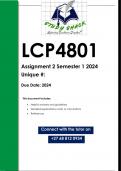LCP4801
Assignment 2 Semester 1 2024
Unique #:
Due Date: 2024
This document includes:
• Helpful answers and guidelines
• Detailed explanations and/ or calculations
• References
Connect with the tutor on
+27 68 812 0934
,© Study Shack 2024. All rights Reserved +27 68 812 0934
, QUESTION 1 (3 ANSWERS PROVIDED)
Article 38(1) of the Statute of the International Court of Justice lists the sources
of international law individually and consecutively, under points (a) to (d) as
follows:
a. international conventions, whether general or particular, establishing
rules expressly recognized by the contesting states,
b. international custom, as evidence of a general practice accepted as law,
c. The general principles of law recognized by civilized nations,
d. Subject to the provisions of Article 59, judicial decisions and the
teachings of the most highly qualified publicists of the various nations,
as subsidiary means for the determination of rules of law1
Although these sources have not been expressed in a single provision,
pronouncing the fact that all sources are of equal force and value, the reality is
that this does not indicate that any hierarchy exists with respect to such sources
‘in all cases’.2 To be sure, Abbas remarks that the structure of Article 38(1) is
‘deceptive’ by implying that the sources should be applied in the order in which
they appear.3 Compounding the apparent confusion is the phrase ‘subsidiary
means’ included in the wording of Article 38(1)(d), which tends to convey that
there are principal sources and subordinate sources.4
The travaux préparatoires are helpful in determining whether or not a hierarchy
exists. Published evidence dating to 1920 reveals that the Permanent Court of
International Justice Advisory Committee of Jurists made it explicit that the
sources should not be considered ‘in the undermentioned order’ or ‘rank in the
order of appearance in Article 38(1)’.5
Nevertheless, in practice, as a result of the crystallization and codification of the
principles of international law through treaties, it is arguable that treaties hold
1 Hennie Strydom (ed) et al, International Law (2 ed Oxford University Press 2020) 73.
2 Hennie Strydom (ed) et al, International Law (2 ed Oxford University Press 2020) 74.
3 Ademola Abass International Law: Cases, Text, Materials (Oxford University Press 2012) 59.
4 Ademola Abass International Law: Cases, Text, Materials (Oxford University Press 2012) 59.
See also Erika De Wet and Jure Vidmar (eds) Hierarchy in International Law: The place of
Human Rights (Oxford University Press 2012) 14.
5 Ademola Abass International Law: Cases, Text, Materials (Oxford University Press 2012) 59-
60.
© Study Shack 2024. All rights Reserved +27 68 812 0934




